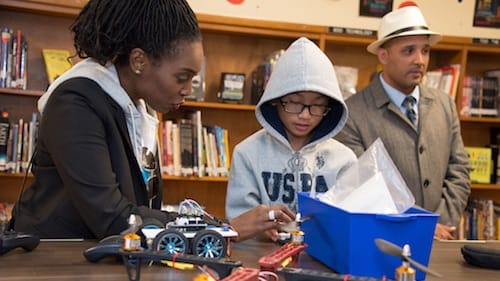When companies give back, everybody wins. But turning a company into an engine of good requires more than a single “magic bullet.” Fortunately, Salesforce knows a thing or two about giving back. With one of the world’s most robust giving programs, more than 3 million hours of volunteering under our belts, and over $240 million dollars donated over the past 20 years, it’s no wonder Fortune ranked Salesforce as the #1 workplace for giving back two years in a row.
Companies that give back and encourage their employees to do the same fare better than those that don’t. Over 1,500 organizations have emulated our philanthropic model and joined Pledge 1%, a global movement to encourage companies to pledge 1% of equity, profit, product, and/or employee time to their communities.

Following through on this pledge can be challenging. Effective corporate and employee philanthropy takes sustained effort at multiple levels. With that in mind — and in honor of Global Day of Giving, which we celebrate today — we identified four key factors that help open the floodgates of goodwill and unleash the power of giving in your organization.
Pillar #1: Culture
A culture that fosters purpose is a must, and philanthropy is an excellent way to establish purpose in the workplace. Philanthropy can also provide a sense of belonging and loyalty, as well as bonding with coworkers, customers, and the community. A common purpose backed by communal action can help build corporate pride and keep a company competitive — both of which feed right back into the culture of the workplace.
Corporate culture starts at the top. How employees speak to one another, work/life balance, trust, and community ultimately come from the CEO. If the CEO and other leaders aren’t working toward a collective purpose or living the values they profess to desire, the rest of the organization is unlikely to follow. To instill an authentic philanthropic culture, the CEO must believe that improving the state of the world is a core company mission and be willing to back up that belief with an investment of both time and money. From former Microsoft Chairman Bill Gates to Shark Tank Shark and AXS TV CEO Mark Cuban — company leaders take personal strides to set the tone for how their corporations view philanthropy.

Pillar #2: Program
Next, a company needs programs that facilitate and encourage giving. These programs should be carefully designed, engineered, and operated, as well as continually adapted over time. Programs should be comprehensive and broadly aligned across all departments, including HR (volunteer time-off policies), marketing (annual giving campaigns), and corporate social responsibility/business (matching and Dollars for Doers programs).
Well-constructed programs can also gently align grassroots employee energy with a company’s strategic impact priorities. For instance, Kellogg’s invests much of its time, money, and energy in ending hunger. This cause aligns with its business, and employees have embraced it. Kellogg’s also encourages employees to engage with their favorite causes through its giving platform, which includes every nonprofit in the U.S. and Canada.

Pillar #3: Marketing
The number-one reason people do things is because someone asks them. Companies need to approach their giving program like they would any other program: with a straightforward call to action. Giving is rarely anyone’s first priority — especially at work — so if a company wants to drive philanthropic engagement, it needs to spread the word about how to participate and pair that communication with specific requests.
Strong marketing programs start with a calendar of planned events throughout the year, often centered around holidays, local charities, and events pertaining to the business itself. Burlington Coat Factory, for instance, runs a coat drive during cold-weather months.
The marketing department should also be able and willing to respond quickly to unexpected events, such as natural or man-made disasters, which often require immediate assistance. Such events spur giving and social media sharing in ways that planned events cannot, and a timely response is critical for both the success of the program and the impact delivered to the community.
Pillar #4 Tools and technology
Programs, policies, executive support, a strong culture, and cross-departmental involvement will get your company most of the way there. The final step is the technology platform to execute, manage, track, and socialize your efforts. Many companies are using a hodgepodge of tools to facilitate giving, volunteering, grants management, and matching opportunities.
A better option is to bring all of these activities together in one place: one platform that offers a marketplace of nonprofits, volunteer opportunities, cause campaigns, and the ability to highlight champions and allow staff to share their experiences with others. The ideal offering would include real-time tracking and reporting, the ability to create campaigns, and a recommendation engine that matches individual interests, behavior, and skills with new opportunities.

Business can be a platform for change
Salesforce.org Philanthropy Cloud is one example of a platform that makes giving back easy for employees, and it reduces the workload for administrators by pulling in fresh content from nonprofits and our partners at United Way.
Technology alone can’t instill a corporate culture or implement a volunteering time-off program, but it can help achieve scale and efficiency. That, combined with a purpose-driven culture, robust cross-departmental programs, and effective internal marketing, can help your company become a powerful force for good.
Learn more about Salesforce.org Philanthropy Cloud by downloading our latest data sheet.




























